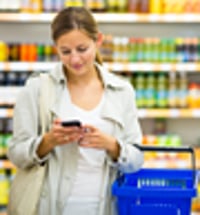As Retail's Future Leaves the Station, CPGs Must Stay on Track
“Missing a train is only painful if you run after it!"
--Nicholas Taleb, The Black Swan: The Impact of the Highly Improbable
Black swan events* are highly improbable, according to Nicholas Taleb. If you look at the history of supermarket retailing, that observation appears relatively true. Clarence Saunders opened the first U.S. self-service supermarket on Sept. 11, 1916. Some 36,876 days later, on Aug. 28, 2017, the second black swan event — Amazon’s acquisition of Whole Foods — will bring these two seemingly disparate companies together.
Now note this from the Mari Gallagher Research & Consulting Group: “The middle customer has a Whole Foods aspiration but wants a Walmart price.” The mash-up of Amazon-Whole Foods will thus further the vision of delivering high-quality, natural/organic and affordable food for a broader cross section of today’s ever-more-discerning "connected consumer."
Another recent black swan was the announcement that Walmart shoppers will soon be able to buy the retailer's product offerings by speaking to their Google Home devices. This partnership, which brings together the world’s largest retailer with the world’s largest search engine, is the latest effort by Walmart to chip away at Amazon’s online dominance.
And now …
We mark an epochal moment where an industry that had evolved at a steady evolutionary pace for 101 years has been derailed by a single acquisition — which closed today. There are many implications for legacy retailers, brands and market strategies.
Amazon and Google have put a new maglev train on the tracks that will serve their digital era connected customer base better than anyone else to date. They will use technology to vertically integrate the process of consumer consumption whether the customer choses brick and mortar, e-commerce, one-hour delivery or click & collect.
Both Walmart and Whole Foods now have the ability to create "markets of one" through a strategic combination of digital and physical mass customization of product. Heterogeneous products can now be matched to heterogeneous consumers more effectively and efficiency.
This will happen not just through price mechanisms, but also through the superordinate vehicle of market information as shoppers use their smartphones, voice assistants Alexa and Google Home, or Amazon’s barcode-scanning wand. Amazon and Google are allowing Whole Foods and Walmart to invent a new method of selling while at the same time transforming the "feeling" of everyday life.
What's the logic of this new market strategy?
It's nothing less than the marriage of physical to digital — aka, the ‘phygital’. To fully appreciate the magnitude of the anticipated impact, consider:
- More than 200 million U.S. consumers own smartphones.
- 62% of smartphone users have made a purchase online using their mobile device in the last six months.
- 80% of shoppers used a mobile phone inside of a physical store to either look up product reviews, compare prices or find alternative store locations.
- An estimated 10 billion mobile connected devices are currently in use worldwide.
- E-commerce dollars now comprise 10% of ALL retail revenue.
Sources: comScore Inc.; OuterBox
What is the impact of this new market strategy?
Both announcements have sent the consumer packaged goods and grocery sectors reeling, with the market recognizing the potential impact of the Walmart/Google and Amazon/Whole Foods pairings:
- Last week, the S&P 500 Food Retail Index closed down almost 5%, as more than $10 billion was wiped off the market value of big food retailers.
- Brittan Ladd, until recently a senior manager with Amazon Fresh, estimated that some grocery retailers have had to invest between $500 million to $1 billion to reduce prices to a level that retained shoppers and resulted in a net increase in shoppers.
- On August 24, the world’s largest advertising group, WPP, cut its growth forecast for the year as clients led by consumer goods firms cut back their marketing budgets.
- Big data/smart data/predictive analytic skill sets are now a requisite.
What are the impact trends to watch?
- Consumer markets will continue and even accelerate their shift from shelf-centric to consumer-centric. Brands can no longer sell what they make; they must make what they can sell. Retailers can no longer sell what they bought; they must buy what they can sell.
- If the consumer lives in a "phygital" world, brands and retailers must also. New rules mean new tools must be invented, tested and deployed in fail-fast mode.
- Competition breeds even more innovation. In-store experiences are being combined with direct-to-consumer delivery. Consumers' product choices will expand from thousands to millions, at their whim vs. through traditional mass merchandising and promotion tactics.
- Voice-activated ordering will become the new normal. There are a number of intersecting technologies emerging that promise to speed consumer adoption. Voice queries on Google already account for about 20% of searches on mobile devices.
- Supply chain pressures, both upstream and downstream, will be devastating for some players. Trading partners have spent decades fine-tuning a mass market supply chain that was focused on shelf replenishment. Today’s order management systems are slow and lumpy. Manufacturing and logistics networks and retailing distribution are pallet-centric. Both will need significant technology and process changes for the the next evolution.
For the companies running after the Amazon/Google train, adjustments have to be made. Change is disruptive. Change is hard. Rewards go to the fast and the fearless.
Hail the Consumer!
* An event or occurrence that deviates beyond what is normally expected of a situation and that would be extremely difficult to predict.


